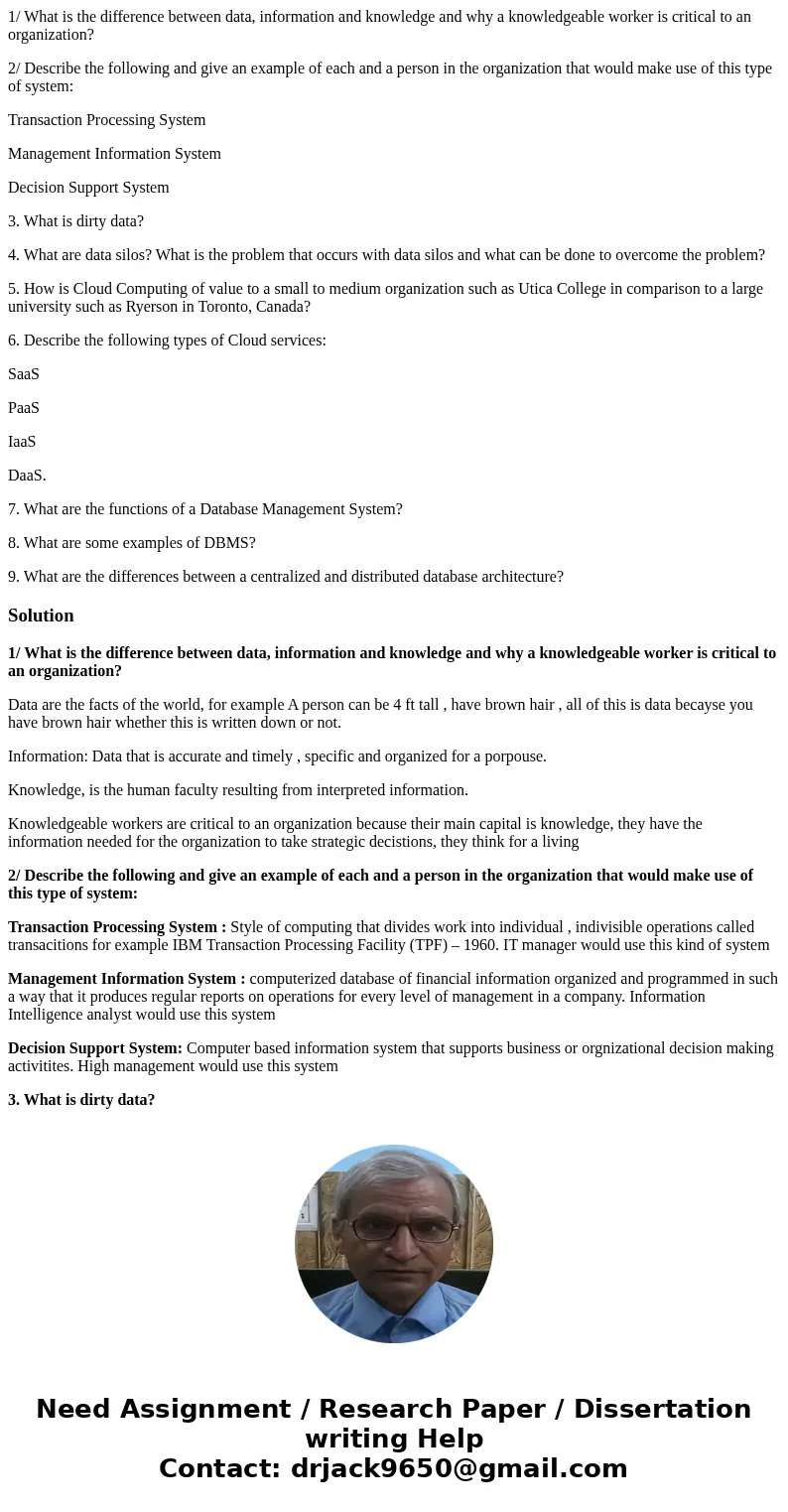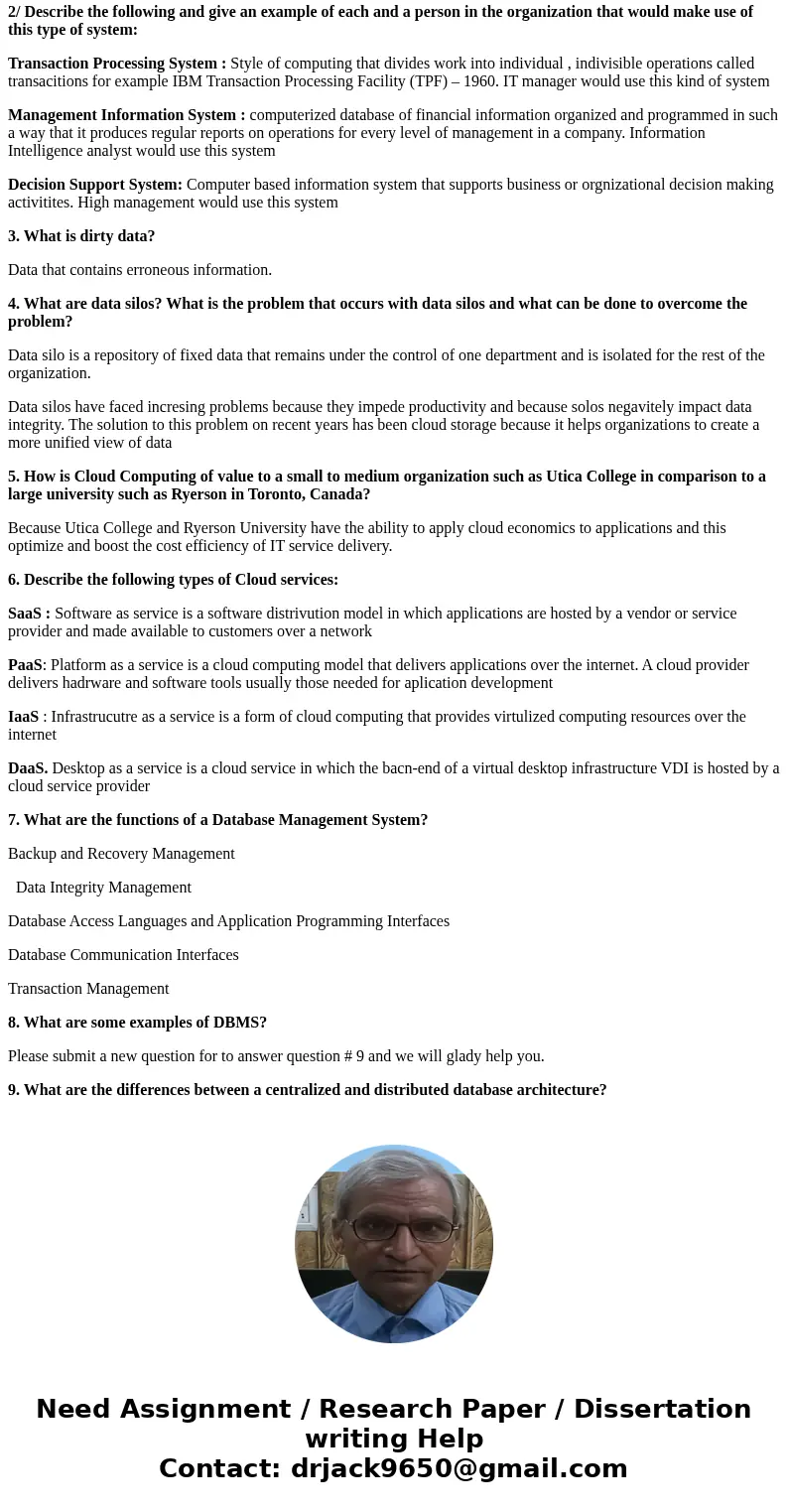1 What is the difference between data information and knowle
1/ What is the difference between data, information and knowledge and why a knowledgeable worker is critical to an organization?
2/ Describe the following and give an example of each and a person in the organization that would make use of this type of system:
Transaction Processing System
Management Information System
Decision Support System
3. What is dirty data?
4. What are data silos? What is the problem that occurs with data silos and what can be done to overcome the problem?
5. How is Cloud Computing of value to a small to medium organization such as Utica College in comparison to a large university such as Ryerson in Toronto, Canada?
6. Describe the following types of Cloud services:
SaaS
PaaS
IaaS
DaaS.
7. What are the functions of a Database Management System?
8. What are some examples of DBMS?
9. What are the differences between a centralized and distributed database architecture?
Solution
1/ What is the difference between data, information and knowledge and why a knowledgeable worker is critical to an organization?
Data are the facts of the world, for example A person can be 4 ft tall , have brown hair , all of this is data becayse you have brown hair whether this is written down or not.
Information: Data that is accurate and timely , specific and organized for a porpouse.
Knowledge, is the human faculty resulting from interpreted information.
Knowledgeable workers are critical to an organization because their main capital is knowledge, they have the information needed for the organization to take strategic decistions, they think for a living
2/ Describe the following and give an example of each and a person in the organization that would make use of this type of system:
Transaction Processing System : Style of computing that divides work into individual , indivisible operations called transacitions for example IBM Transaction Processing Facility (TPF) – 1960. IT manager would use this kind of system
Management Information System : computerized database of financial information organized and programmed in such a way that it produces regular reports on operations for every level of management in a company. Information Intelligence analyst would use this system
Decision Support System: Computer based information system that supports business or orgnizational decision making activitites. High management would use this system
3. What is dirty data?
Data that contains erroneous information.
4. What are data silos? What is the problem that occurs with data silos and what can be done to overcome the problem?
Data silo is a repository of fixed data that remains under the control of one department and is isolated for the rest of the organization.
Data silos have faced incresing problems because they impede productivity and because solos negavitely impact data integrity. The solution to this problem on recent years has been cloud storage because it helps organizations to create a more unified view of data
5. How is Cloud Computing of value to a small to medium organization such as Utica College in comparison to a large university such as Ryerson in Toronto, Canada?
Because Utica College and Ryerson University have the ability to apply cloud economics to applications and this optimize and boost the cost efficiency of IT service delivery.
6. Describe the following types of Cloud services:
SaaS : Software as service is a software distrivution model in which applications are hosted by a vendor or service provider and made available to customers over a network
PaaS: Platform as a service is a cloud computing model that delivers applications over the internet. A cloud provider delivers hadrware and software tools usually those needed for aplication development
IaaS : Infrastrucutre as a service is a form of cloud computing that provides virtulized computing resources over the internet
DaaS. Desktop as a service is a cloud service in which the bacn-end of a virtual desktop infrastructure VDI is hosted by a cloud service provider
7. What are the functions of a Database Management System?
Backup and Recovery Management
Data Integrity Management
Database Access Languages and Application Programming Interfaces
Database Communication Interfaces
Transaction Management
8. What are some examples of DBMS?
Please submit a new question for to answer question # 9 and we will glady help you.
9. What are the differences between a centralized and distributed database architecture?


 Homework Sourse
Homework Sourse